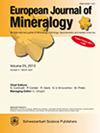H2O and Cl in deep crustal melts: the message of melt inclusions in metamorphic rocks
IF 1.7
3区 地球科学
Q2 MINERALOGY
引用次数: 0
Abstract
Abstract. The use of NanoSIMS on primary melt inclusions in partially melted rocks is a powerful approach to clarify the budget of volatiles at depth during crust formation and its reworking. Anatectic melt inclusions are indeed gateways to quantify H2O, halogens and other species (e.g. CO2, N) partitioned into the deep partial melts generated during metamorphism of the continental crust. Here we present new datasets of NanoSIMS measurements of H2O and Cl in preserved melt inclusions from metamorphic rocks with different protoliths – magmatic or sedimentary – which underwent partial melting at different pressure–temperature–fluid conditions. These new datasets are then compared with similar data on natural anatectic melts available in the literature to date. Our study provides novel, precise constraints for the H2O content in natural melts formed at high pressure, a field previously investigated mostly via experiments. We also show that H2O heterogeneities in partial melts at the microscale are common, regardless of the rock protolith. Correlations between H2O contents and P–T values can be identified merging new and old data on anatectic inclusions via NanoSIMS. Overall, the data acquired so far indicate that silicate melt generation in nature always requires H2O, even for the hottest melts found so far (>1000 ∘C). Moreover, in agreement with previous work, preserved glassy inclusions always appear to be poorer in H2O than crystallized ones, regardless of their chemical system and/or P–T conditions of formation. Finally, this study reports the very first NanoSIMS data on Cl (often in amounts >1000 ppm) acquired in situ on natural anatectic melts, showing how anatectic melt inclusions – additionally to magmatic ones – may become a powerful tool to clarify the role of halogens in many geological processes, not only in crustal evolution but also in ore deposit formation.地壳深层熔体中的 H2O 和 Cl:变质岩中熔体包裹体的信息
摘要。对部分熔融岩石中的原生熔体包裹体使用纳米SIMS是澄清地壳形成及其再加工过程中深部挥发物预算的有力方法。在大陆地壳变质过程中产生的深部部分熔体中,极性熔体包裹体确实是量化 H2O、卤素和其他物种(如 CO2、N)的通道。在这里,我们介绍了在不同压力-温度-流体条件下部分熔化的不同原岩(岩浆岩或沉积岩)变质岩中保存的熔体包裹体中的 H2O 和 Cl 的 NanoSIMS 测量新数据集。然后将这些新数据集与迄今为止文献中关于天然无极熔体的类似数据进行比较。我们的研究为在高压下形成的天然熔体中的 H2O 含量提供了新颖、精确的约束条件,而这一领域以前主要是通过实验进行研究的。我们的研究还表明,部分熔体中的 H2O 在微观尺度上的异质性很常见,与岩石原岩无关。H2O 含量与 P-T 值之间的相关性可以通过 NanoSIMS 合并有关无酸性包裹体的新旧数据来确定。总之,目前获得的数据表明,自然界中硅酸盐熔体的生成总是需要 H2O,即使是目前发现的最热熔体(>1000 ∘C)也是如此。此外,与之前的研究一致,保存下来的玻璃状包裹体似乎总是比结晶包裹体的 H2O 含量低,无论其化学体系和/或形成的 P-T 条件如何。最后,本研究报告了在天然无盐熔体中原位获取的第一批有关 Cl(通常含量大于 1000 ppm)的 NanoSIMS 数据,显示了无盐熔体包裹体--除了岩浆包裹体之外--如何成为一种强大的工具,用于澄清卤素在许多地质过程中的作用,不仅在地壳演化过程中,而且在矿床形成过程中。
本文章由计算机程序翻译,如有差异,请以英文原文为准。
求助全文
约1分钟内获得全文
求助全文
来源期刊
CiteScore
2.80
自引率
9.50%
发文量
40
审稿时长
6-12 weeks
期刊介绍:
EJM was founded to reach a large audience on an international scale and also for achieving closer cooperation of European countries in the publication of scientific results. The founding societies have set themselves the task of publishing a journal of the highest standard open to all scientists performing mineralogical research in the widest sense of the term, all over the world. Contributions will therefore be published primarily in English.
EJM publishes original papers, review articles and letters dealing with the mineralogical sciences s.l., primarily mineralogy, petrology, geochemistry, crystallography and ore deposits, but also biomineralogy, environmental, applied and technical mineralogy. Nevertheless, papers in any related field, including cultural heritage, will be considered.

 求助内容:
求助内容: 应助结果提醒方式:
应助结果提醒方式:


